Wildflowers, Grasses and Other Nonwoody Plants
Media

Species Types
Scientific Name
Cirsium vulgare
Description
Bull thistle is a weedy introduction from Europe, found statewide. To tell it from our other thistles, note its stems with spiny-margined wings, and its leaves with the upper surface strongly roughened with stiff, spiny bristles.
Media

Species Types
Scientific Name
Cirsium altissimum
Description
Tall thistle is a native thistle that can grow to be 10 feet tall! To identify it, notice its leaves, which are unlobed (though they may be wavy or have only shallow, broad lobes), are felty-hairy beneath, and have prickles only along the edges.
Media
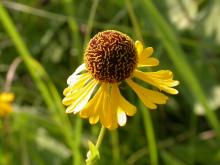
Species Types
Scientific Name
Helenium flexuosum
Description
The purplish or brownish disk florets of purple-headed sneezeweed set it apart from our other sneezeweeds, whose centers are yellow. Look for it in moist, open areas, mostly in the southern half of the state.
Media

Species Types
Scientific Name
Elephantopus carolinianus
Description
You may not recognize elephant’s foot as a member of the daisy or sunflower family because it lacks petal-like ray florets. Also, it has unusual, doubly compound flower clusters. And how did it get its name, anyway?
Media
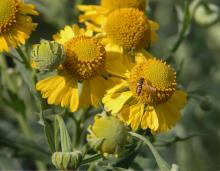
Species Types
Scientific Name
Helenium autumnale
Description
Autumn sneezeweed is a late-blooming perennial with conspicuously winged stems. The flowerheads have yellow, domed disks. The ray flowers are fan-shaped, yellow, and notched.
Media

Species Types
Scientific Name
All true grasses (species in the grass family)
Description
Missouri has 276 species in the grass family, including well-known crop plants and our native prairie grasses. Distinguishing between the species can be difficult, but it’s easy to learn some basics about the group.
Media
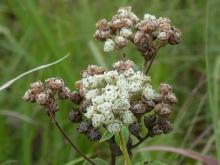
Species Types
Scientific Name
Parthenium integrifolium
Description
A common component of high-quality upland prairie, American feverfew, or wild quinine, is a native wildflower that was used to treat fevers or malaria. It's in the composite family.
Media
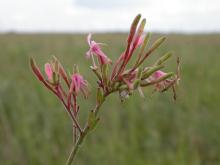
Species Types
Scientific Name
Oenothera filiformis (formerly Gaura longiflora, G. biennis)
Description
Large-flowered gaura is a tall plant whose white flowers turn pinkish as they age. Four petals point upward, then bend back, and 8 stamens droop downward. The flowers look something like small butterflies.
Media

Species Types
Scientific Name
Geum canadense
Description
White avens, a common wildflower in the rose family, may not catch your eye during hikes, but you will probably notice the seeds clinging to your socks when you get home!
Media
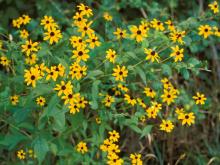
Species Types
Scientific Name
Rudbeckia triloba
Description
Brown-eyed Susan is a bushy perennial with much-branching stems and plenty of flowerheads. Compared to Missouri’s other Rudbeckia species, its flowerheads are the smallest, growing to only about one inch across.
See Also
About Wildflowers, Grasses and Other Nonwoody Plants in Missouri
A very simple way of thinking about the green world is to divide the vascular plants into two groups: woody and nonwoody (or herbaceous). But this is an artificial division; many plant families include some species that are woody and some that are not. The diversity of nonwoody vascular plants is staggering! Think of all the ferns, grasses, sedges, lilies, peas, sunflowers, nightshades, milkweeds, mustards, mints, and mallows — weeds and wildflowers — and many more!





















